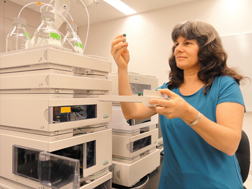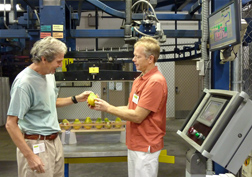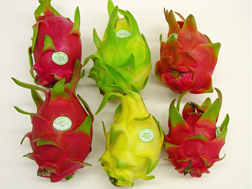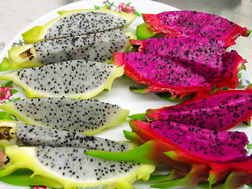Phytosanitizing Hawaiian Fruit
A Technology Transfer Success Story
Papaya, rambutan, longan, dragon fruit, and purple-fleshed sweetpotato are just some of the delicious tropical fruits and vegetables gaining popularity in the continental United States. Chances are these delectable delights, now found in grocery stores and specialty Asian supermarkets all over the country, were grown in Hawaii.
But just 5 years ago, one would have been hard pressed to find these healthy and tasty Hawaiian treats. That’s because the export potential of Hawaiian produce was limited by strict quarantine restrictions and phytosanitary measures to ensure that agricultural pests such as fruit flies didn’t invade the mainland. These export restrictions have cost Hawaiian growers around $300 million per year in lost sales.
Research by entomologist Peter Follett and food technologist Marisa Wall has changed all of that. The scientists, who work at the Pacific Basin Agricultural Research Center in Hilo, Hawaii, are the first to apply generic irradiation protocols to control a wide variety of quarantine insect pests found on fresh commodities.
Based partly on the scientists’ extensive research, the U.S. Department of Agriculture’s Animal and Plant Health Inspection Service (APHIS) in 2006 published a landmark rule accepting the generic doses for treatment of Hawaiian produce. “APHIS had the courage to take the step of turning our research into regulations. Without their hard work, growers and consumers wouldn’t be able to benefit from this research,” says Follett.
|
|
No Pests on These Products
In 2000, the first commercial irradiation facility dedicated to treating fresh produce for export was built by Hawaii Pride LLC. Initially, the facility was unable to process large amounts of product because each type of fruit or vegetable required a different protocol for treatment.
“Quarantine or phytosanitary treatments such as heat, cold, irradiation, and fumigation are used to disinfest commodities like fruits and vegetables of insect pests before they are exported to areas where the pests aren’t found,” explains Follett. “Typically, entomologists have to develop treatments for one pest and commodity at a time, which can take years of research.”
Seeing that Hawaii’s small farmers were extremely interested in using phytosanitary irradiation as an alternative to the costly methyl bromide treatment for exports, Follett and Wall began promoting a “generic protocol” that could control a broad variety of pests on a wide range of commodities with one treatment. The scientists worked closely with Hawaii Pride, APHIS, and local growers and exporters to conduct research on using the generic treatments to control key quarantine pests.
|
|
The researchers used the Hawaii Pride facility and its new, $6 million state-of-the-art electron-beam x-ray irradiator—the only one of its kind—to test radiation limits on a variety of fruits and vegetables. “X-ray radiation penetrates the produce easily, so treatment time is short, and the required dose can be applied without changing the fruit’s or vegetable’s temperature,” says Follett.
Follett conceived, designed, and executed extensive irradiation experiments to determine the levels needed to control quarantine insects. He found that a generic dose of 150 Grays (Gy) of radiation is suitable for controlling the three species of tephritid fruit flies found in Hawaii, which contributed to APHIS approval of this dose for all tephritid fruit flies. He also demonstrated that a generic dose of 400 Gy is broadly effective against many other pests of fruits and vegetables. This is the most widely used generic treatment today.
But just because a generic dose is available doesn’t mean growers will use it. They want to ensure that their product will still be at its best when it reaches the mainland. That’s where Wall comes in. She’s responsible for examining product quality after exposure to radiation.
|
|
“Irradiation adds another step to the postharvest process, which puts added stress on the commodity,” says Wall. “To establish maximum dose levels, we conducted tests for composition, quality, and visual damage to see exactly how much radiation the product can tolerate. We also replicated shipping and storage conditions to assess whether the consumer would receive a high-quality product.”
Wall concluded that most commodities can tolerate irradiation at levels that control pests. But she cautions that not all commodities behave the same when exposed to radiation. “We found that different varieties of a fruit or vegetable react differently to the same radiation doses. Maturity, time of harvest, and several other factors can also affect product quality.”
Variations aside, Follett and Wall’s research has opened up the market for Hawaiian produce. The Island State currently uses generic irradiation treatments to export 15-20 million pounds of various tropical fruits and vegetables annually.
The technology has made it easier and less costly for Hawaiian growers to share their produce with consumers on the mainland. As a result of their efforts, Follett and Wall received a 2010 Federal Laboratory Consortium Award for Excellence in Technology Transfer.
|
|
More Research Means More Produce
Hawaiian growers and exporters are not the only ones benefitting from the scientists’ research. In 2009, the International Plant Protection Commission approved the generic radiation dose of 150 Gy for tephritid fruit flies, facilitating the worldwide adoption of this technology.
There are currently a handful of countries using the generic protocols on a variety of commodities. India, Thailand, Vietnam, Mexico, and Pakistan recently received APHIS approvals to export tropical fruits to the United States using generic irradiation treatments. Indonesia, the Philippines, Peru, and South Africa are awaiting their approvals.
Follett is now trying to determine whether lower doses of radiation will be effective in controlling quarantine pests. Lower doses would result in less damage to the produce, help lower the costs of treatment, and allow larger amounts of produce to be processed.
Wall is currently studying how mixtures of different fruits packed in the same box are affected during the postharvest period. Follett found that the radiation doses that have been approved by APHIS to control quarantine pests on single-commodity shipments can also be used to treat shipments containing mixed fruits and vegetables. Some fruits, however, produce more ethylene gas in response to irradiation, causing other fruits to ripen more quickly. Wall is trying to determine the right mix of fruits that can be packed together so that one day we may be able to enjoy a lovely collection of tropical fruit directly from Hawaii.—By Stephanie Yao, formerly with ARS.
This research supports the USDA priority of ensuring food safety and is part of Crop Protection and Quarantine, an ARS national program (#304) described at www.nps.ars.usda.gov.
Peter Follett and Marisa Wall are in the USDA-ARS Tropical Crop and Commodity Protection Research Unit, Pacific Basin Agricultural Research Center, 64 Nowelo St., Hilo, HI 96720; (808) 959-4303 [Follett], (808) 959-4343 [Wall].
"Phytosanitizing Hawaiian Fruit: A Technology Transfer Success Story" was published in the February 2011 issue of Agricultural Research magazine.











